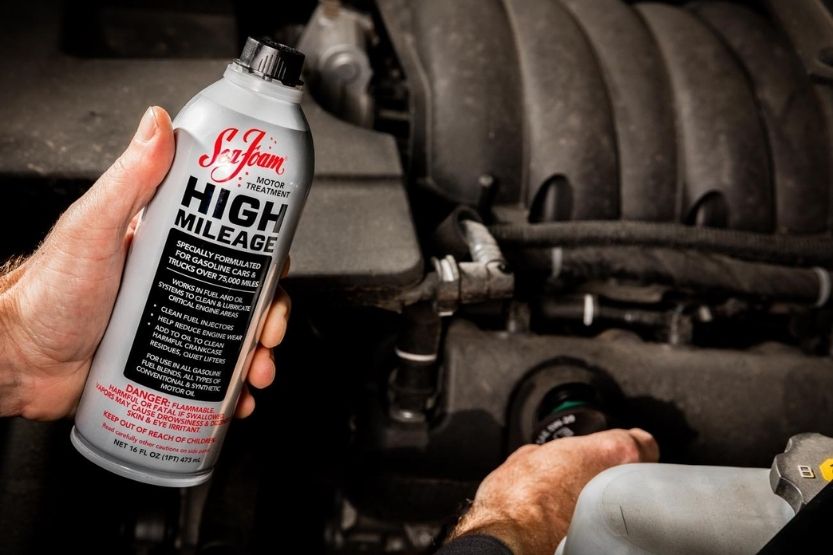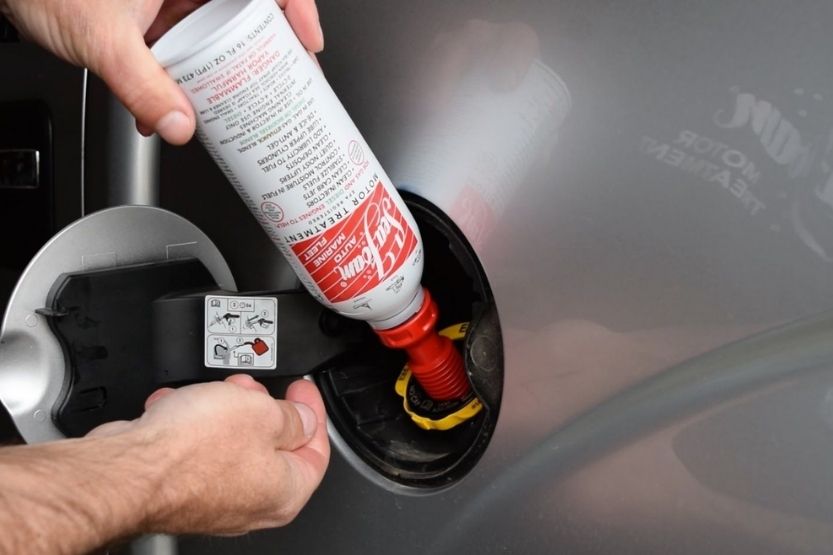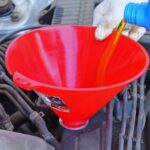Automotive engines lose efficiency if so many varnish residues, sludge, and petroleum gum are in their carburetor channels. You need to clean these deposits with Seafoam to restore full engine capacity. Seafoam in oil – how to use and for how long?
The customary way of using Seafoam is by adding 1 to 1.5 ounces of this motor treatment to every quart of motor oil. You can add Seafoam any time between your oil change intervals. However, the recommendation is to add Seafoam to your car’s oil crankcase around 100 to 300 drive miles before changing the oil and filter.
You should not add the whole bottle of Seafoam to the motor oil. As a solvent, its purpose is to clean engine parts and not just lubricate them.
Usually, only about 1/3 of the bottle is added into the gas tank, 1/3 bottle to the main vacuum line leading to the intake, and 1/3 bottle to the motor oil. Run the engine for around 15 minutes and change the motor oil entirely.
Read on to learn more about Seafoam oil, what it is, how it is used, and for how long.
Seafoam in Oil

Add Anytime Between the Change Oil Intervals
The normal way of using Seafoam in engine oil is by adding 1 to 1.5 ounces to every quart of motor oil. You can add Seafoam anytime between your change oil intervals. However, you should add Seafoam to your oil crankcase about 100 to 300 miles before changing the motor oil and the filter.
Do Not Add the Whole Bottle of Seafoam to the Motor Oil
It’s not good to add the whole bottle of Seafoam to the motor oil. Since it is a solvent, its basic function is to clean and lubricate engine parts. So, the typical way they use it is to add 1/3 bottle to the oil, 1/3 bottle to the main vacuum line to the intake, and 1/3 bottle to the gas tank. Then run your engine for around 15 minutes and change the oil.
Is Seafoam in Oil Good or Bad?
This product will not damage your engine because it is made from highly-refined petroleum, making it 100% safe. When you have Seafoam in your tank, it will clean the entire car’s fuel system and lubricate engine parts as well.
What Is Seafoam?
Effectively and Safely Dissolve Varnish Residues
Seafoam oil is designed to work with fuel to effectively and safely dissolve varnish residues, deposits, and petroleum gum. It helps clean carburetor passages and restores the normal functioning of the engine.
Comes in Spray Bottles
It also comes in spray bottles and can provide high fuel cleaning solvency to injection intakes and carburetors. This product contains organic petroleum ingredients. There are no abrasive chemicals or harsh ingredients in this product that can harm a car’s fuel system and engine.
Products You Can Safely Mix with Seafoam
You can safely add Seafoam to the following products:
- Petroleum fuels of all kinds, including diesel, ethanol, and gasoline, as well as their all their blends.
- Any type and make of diesel and gasoline.
- Any type of engine crankcase that uses any type and variations of synthetic or conventional motor oil.
Helps Clean and Dissolve Dangerous Deposits from Car’s Components
Seafoam can help clean and dissolve dangerous deposits and residues from the following:
- Carburetors
- Chambers
- Injectors
- Intake valves
This product can also help fuels to resist evaporation. It can prevent varnish and gum formation and maintain ignition vapors.
General Recommendations on the Use of Seafoam in Diesel and Gasoline Engines

How to Apply Seafoam
You can use Seafoam in both diesel and gasoline engines. In this regard, there are general recommendations on using Seafoam in oil:
1. Determine the Engine’s Crankcase Oil Capacity
Before using Seafoam, the first thing you need to do is determine your engine’s crankcase oil capacity. Most light trucks and cars have crankcases that can hold from five to six quarts of oil. To be sure, refer to your car’s operator’s manual.
2. Add One Ounce of Seafoam for Each Quart of Oil
Seafoam Motor Treatment comes in 16-ounce cans. One can is enough to treat 16 quarts of oil. To use it, you need to add just one ounce of Seafoam for each quart of oil in the engine’s crankcase.
3. Remove the Oil Filler Cap
When you are ready to use Seafoam, first remove the oil filler cap of the engine crankcase. And then pour the recommended quantity of Seafoam directly into the engine crankcase. You should not pour more than recommended for every oil change interval.
4. For Crankcase Oil Applications
In adding Seafoam to crankcase oil, the following are the recommendations:
- When checking the dipstick, always perform oil change when the oil gets dark.
- Add 1 to 1.5 ounces of Seafoam per quart of oil. This rule applies to all four-cycle diesel and gasoline engines.
- You can add Seafoam any time between your oil changes. How long to leave Seafoam in this case? The recommendation is to add it to the crankcase oil about 100 to 300 drive miles before performing change oil and filter.
- When ready, take of the oil filler cap and pour the right amount of Seafoam directly into the crankcase of the engine. You are advised not to exceed one treatment for every oil change.
5. Other Tips
You can safely use Seafoam depending on how you use your car. In other words, there are different ways of using Seafoam, and it depends on the usage of the engine:
- Frequently Used Engines (e.g. trucks and cars that are driven regularly) : Add one or two cans of Seafoam to the fuel for every 2,000 to 5,000 drive miles.
- Engine Equipment – Add Seafoam to the fuel tank every three months or even a little sooner.
- Engines Not Used Regularly – Add Seafoam to the fuel tank; engine manufacturers recommend protection for their engines because unprotected engines will degrade in just a matter of 30 days.
Again, what does Seafoam in oil do? Applying Seafoam in an engine oil crankcase can clean and liquefy heavy oil deposits and prevent sludge formation. This way, you are draining residues before the oil change.
How to Use Seafoam on Diesel Engines

How Does Seafoam Restore and Protect Diesel Fuel Systems
Seafoam is also effective in restoring and protecting diesel fuel systems in the following manner:
- Stabilizes diesel fuels;
- Cleans the contaminants and the deposits from the oil crankcase and thereby restores flow of oil to restricted oil passages;
- Adds lubricity to diesel fuel and to the components of the fuel system;
- Controls small amounts of moisture;
- Restores the pattern of diesel injectors by removing carbon and soot deposit from injector nozzles thereby restoring lost fuel volume and recovering engine power; and
- Cleans chamber areas and fuel injectors by dissolving varnish and gum formations in the entire fuel system.
How to Use Seafoam in Cleaning Diesel Injectors
Seafoam is effective in cleaning diesel injectors. It is convenient since you do not have to remove the injectors’ parts when cleaning. Here are the steps on how you can use Seafoam for this purpose:
1. Turn on the Engine
Turn on the engine until it reaches its operating temperature, and then turn it off.
2. Remove the Primary Fuel Filter
After removal, drain the filter and filter housing. At this point, manufacturers recommend replacing the old filter with a new one. It’s not an absolute requirement, though.
3. Pour Seafoam
Fill the entire filter and its housing with Seafoam. This will depend on the type of filter used.
4. Reinstall the Cleaned Filter
Reinstall the cleaned filter or install the new filter. Ensure that no air is in the filter or its housing.
5. Run the Engine for Two Minutes
With the filter primed, turn on the engine and allow it to run for two minutes. Then turn it off.
6. Allow the Deposit to Soak
Wait for about five to fifteen minutes so that Seafoam will be able to soak into the deposit and gum buildup.
7. Drive the Car for 30 Miles
Then turn on the engine and drive your car for 30 miles or operate the engine for approximately the same amount of time. If possible, put your car to the task as hard as you can. You are asking the engine to run under load to generate the right amount of heat and compression, resulting in its optimal cleaning.
How to Use Seafoam on Gasoline Engines
When used in gasoline engines, Seafoam can effectively and safely clean gasoline that fuel additives cannot do. This product can deliver high concentrations of gasoline cleaning solvency to the following parts:
- Intake runners,
- Chamber areas,
- Throttle bodies,
- Pistons, and
- Valves.
To restore the performance and to protect the injection intakes of gasoline engines, the process of hot soaking them with Seafoam is used.
Steps on How to Perform Hot Soaking Process
Here are the steps in this hot soaking process:
1. Warm up the Engine
Warm up the engine to its operating temperature. Turn off any accessories and then shut the engine off.
2. Locate the Hose Clamp
It connects the air intake boot over the throttle body. And then loosen its clamp and pull out the intake boot from the throttle body.
3. Put the Hook Guide with the Tube on the Throttle Body
Put the hook guide with the tube on the throttle body. Or between the throttle plate and the sealed air intake. Direct the tube nozzle at the throttle plate. Position the nozzle in front of the throttle plate. Or the spot where the plate veers away from the nozzle.
4. Spray Seafoam on the Injection Intakes
Start spraying Seafoam on these injection intakes. When spraying, always spray downstream from the mass airflow sensor.
5. Re-install the Intake Boot
Reinstall the intake boot over the throttle body and the hook guide.
6. Start the Engine
Ask your helper to start the engine and hold it at 1,000 rpm over the recommended idle of the manufacturer for the whole time you are conducting this spray treatment.
7. Spray Until the Seafoam Can Is Empty
With the right tube attached to the Seafoam can, continuously spray until the can is empty. This will take around four to five minutes of spraying.
8. Turn the Engine Off
Tell your helper to turn the engine off when you have emptied the Seafoam can. Allow the engine to soak the Seafoam for around five to 15 minutes.
9. Remove the Air Intake
Remove the air intake to recover the cleaning tube and guide. And then reinstall the boot over the throttle body. Next, tighten the hose clamp.
10. Drive the Car for About Five Minutes
After hot soaking the injection intakes, turn on the engine again and drive your car for about five minutes. Try to accelerate if it’s safe.
If you need to clean your car’s carburetor with Seafoam, you must follow the above procedure. But you need to remove the air cleaner and insert the spray tube of the Seafoam can into the throat of the carburetor. Follow the same procedure for small carburetors of smaller power and garden tools.
How Much Sea Foam to Use?
The amount of Seafoam you need to use depends on how you use it. Generally, you can use Seafoam for cleaning and maintenance:
Cleaning
For cleaning purposes, you can safely add more Seafoam to the fuel. The more Seafoam in the fuel, the better it will clean the engine parts. Start by adding two ounces per gallon of fuel. Then increase the amount as required. The ratio could be as high as 50% fuel to Seafoam for induction cleaning devices.
Maintenance
If you are using Seafoam for stabilizing stored fuel, the recommendation for all types of fuel is one ounce per gallon of fuel. One pint of Seafoam can treat 16 gallons of fuel. And one gallon of Seafoam can treat 128 gallons of fuel. Seafoam is directly poured into the fuel tank.
Conclusion: Seafoam in Oil
Most car owners add 1 to 1.5 ounces of Seafoam to every quart of motor oil. You can add this motor oil treatment any time between change oil intervals. You are advised to add Seafoam to the oil crankcase of your car about 100 to 300 drive miles before changing the motor oil and the oil filter.
Seafoam is safe to use. It is made from highly refined petroleum. If you put the correct amount in your fuel tank, it will clean your car’s entire fuel system and lubricate some of the engine parts as well.
Related reading:






![C-clamp for Brakes [8 Best and What Size Should You Use?] c clamp for brakes](https://roadsumo.com/wp-content/uploads/2022/05/c-clamp-for-brakes-150x150.jpg)

![Read more about the article How to Read a Dipstick [Easy Steps and Tips]](https://roadsumo.com/wp-content/uploads/2022/01/how-to-read-a-dipstick-300x200.jpg)
